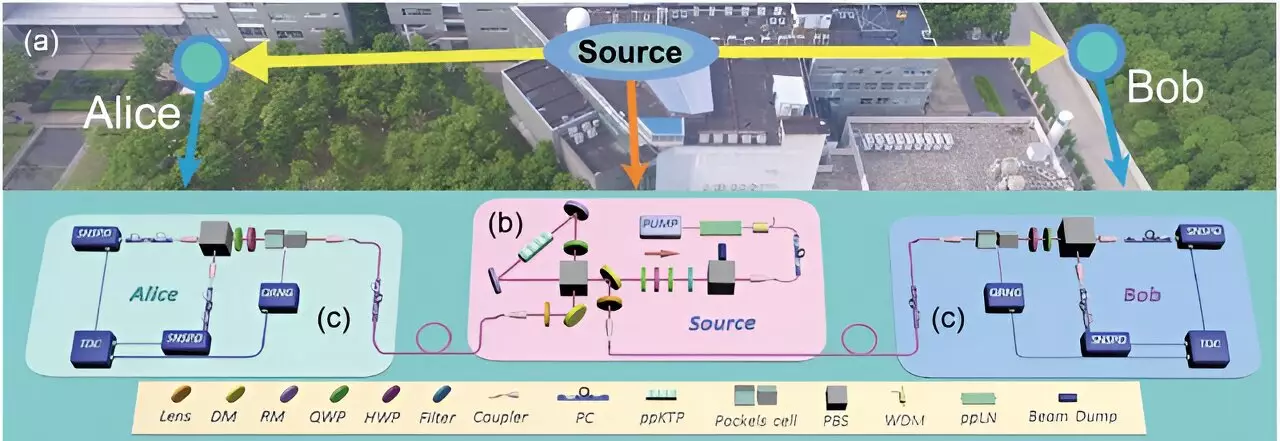The recently published results concerning Hardy’s paradox mark a pivotal advancement in the realm of quantum mechanics. Introduced by Lucien Hardy in the late 1990s, this paradox presents a compelling challenge to the classical notion of local realism—the idea that physical objects possess definite attributes independent of measurement and that no information travels faster than light. Hardy’s paradox ingeniously showcases how quantum phenomena can contradict local realism by illustrating scenarios in which certain quantum events possess a non-zero probability, despite the classical theory predicting otherwise. The implications of Hardy’s paradox can reshape our understanding of the universe and quantum entanglement.
The pioneering research team, spearheaded by Prof. Pan Jianwei and including members from the University of Science and Technology of China and Nankai University, has successfully conducted a loophole-free test of this paradox for the first time. Historically, experiments grounded in Hardy’s framework have struggled to attain conclusive results thanks to two primary loopholes: the locality loophole, which allows for the possibility that outcomes may influence each other due to measurement setups, and the detection efficiency loophole, which relates to the losses encountered in optical systems.
To tackle these challenges, the researchers executed a meticulously designed experimental framework. Their innovative approach guaranteed that the measurement settings were space-like separated from the photon detection process, effectively neutralizing any local influences on the outcomes of the experiment. This spatial separation is critical; it ensures that no signaling can occur between the measurement choices and the results, thereby preserving the integrity of the nonlocal phenomenon the researchers aimed to validate.
In a marked effort to close the detection efficiency loophole, the study achieved an impressive detection rate of 82.2%. This high efficiency significantly reduces the risk of optical losses undermining the validity of the experiment’s conclusions. Furthermore, to guarantee the true randomness of measurement settings, the research team integrated quantum random number generators—essential elements that enhance the authenticity of their data by precluding any potential intervention from local hidden variables.
The integration of double-click events and undetected counts into their analysis through a sophisticated revision of Hardy’s inequality was another impressive aspect of the research. By including these factors, the researchers advanced the methodology for testing Hardy’s paradox, presenting a well-rounded and nuanced contribution to quantum physics.
Conducted over six hours and involving the analysis of 4.32 billion trials, the experiment revealed a strong and definitive violation of Hardy’s paradox with a staggering significance level of 5 standard deviations. The null hypothesis test indicated an astronomical improbability—less than 10^-16348—of attributing these results to local realism. This demonstrates that the experimental outcomes not only defy classical interpretations but also provide robust evidence for the reality of quantum nonlocality.
The ramifications of this breakthrough extend beyond theoretical implications. With a clearer understanding of quantum nonlocal processes, the research opens new avenues for advancing quantum technologies. Applications in quantum key distribution and quantum random number certification are on the horizon, offering practical frameworks for enhancing security protocols in communication technologies.
The work undertaken by the research team not only reinforces the fundamental discrepancies between quantum mechanics and local realism but also expedites the evolution of quantum information technologies. As we delve deeper into the mysteries of quantum mechanics, achieving a loophole-free demonstration of Hardy’s paradox serves as a cornerstone for future explorations in this field. The findings contribute significantly toward unraveling the intricacies of nonlocal interactions and establish a robust platform for leveraging quantum mechanics in real-world applications. Thus, this experiment stands as a testament to scientific innovation, fostering curiosity about the quantum realm and its potential to redefine the limits of our technical achievements.

